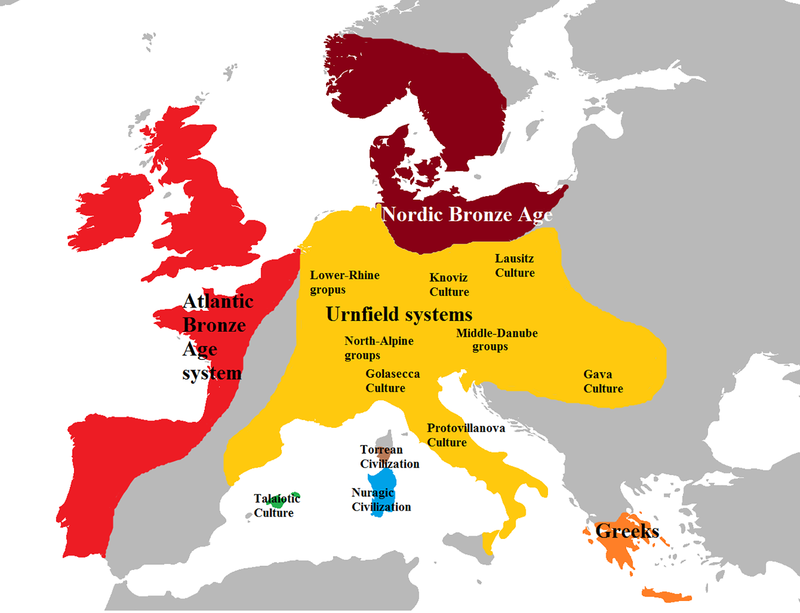I have just noticed that Genetiker ran the admixtures for a Unetice genome and an Urnfield genome. Here is a comparison with the Yamna and Bell Beaker genomes. There doesn't seem to be a big difference between Bell Beaker, Unetice and Urnfield. Let's keep in mind that these are individual genomes, not average of several genomes for one period. I expect that the averages should be even closer.
The considerably higher West Asian admixture in the Urnfield sample piqued my interest. The Urnfield culture marks an unprecedented break in the funerary practices of Indo-European peoples. From the Early Bronze Age (Yamna) and until the Late Iron Age, Indo-European speakers always buried their leaders in tumuli (aka kurgan or burial mounds) with prized possessions (just like the Pharaohs of Egypt). The only exceptions were the ancient Greeks (except the Mycenaeans) and Romans (although Roman tumuli have been found in Gaul), who cremated their dead. This was also the case of the short-lived Urnfield culture (1300-1200 BCE), which spanned across most of Central Europe, Italy, eastern France and Catalonia. Urnfield succeeded to the Tumulus culture, itself descended from Unetice, and preceded the Hallstatt culture.
What is fascinating is that the Urnfield culture existed at the time when all the great East Mediterranean civilizations collapsed around 1200 BCE, and that cremation was at the time an East Mediterranean practice, which spread to Greece then to Italy, probably with J2 people and the West Asian admixture.
So the fact that the Urnfield sample had twice more West Asian than the Unetice, and four times more than the Bell Beaker, is intriguing to say the least.
The Gedrosian admixture is stable at 12% in Unetice and Urnfield, so it is not related to a higher Yamna or R1b ancestry.
The MDLP K=15 admixtures show that the West Asian component may actually have come from the Balkans. The Urnfield sample has 13.77% of Balkanic-1, against 7.70% for Unetice, and 0.00% for the Yamna sample.
This all suggests that the cremation practice of the Unrfiled systems could have originated in the Balkans, possibly with an presently unknown migration of J2 people ultimately from Anatolia. The oldest J2 sample found in Europe to date was a J2a1 from Hungary dated 1270-1110 BCE, i.e. exactly during the Urnfield period. Hungary was at the time part of the Urnfield culture too.
| Admixture | Yamna | Bell Beaker | Unetice | Urnfield |
| West European | 49.08% | 61.53% | 53.45% | 53.36% |
| East European | 20.88% | 8.94% | 12.79% | 10.23% |
| Mediterranean | 0.47% | 19.21% | 24.43% | 23.45% |
| West Asian | 17.42% | 2.61% | 4.77% | 11.04% |
| Southwest Asian | 0% | 5.29% | 2.68% | 0% |
| South Asian | 8.42% | 0.01% | 0.89% | 0.47% |
| Southeast Asian | 0% | 0% | 0% | 0% |
| Northeast Asian | 3.74% | 0% | 0.02% | 1.45% |
| Northwest African | 0% | 0% | 0% | 0% |
| East African | 0% | 0% | 0.44% | 0% |
| Neo African | 0% | 0.69% | 0.52% | 0% |
The considerably higher West Asian admixture in the Urnfield sample piqued my interest. The Urnfield culture marks an unprecedented break in the funerary practices of Indo-European peoples. From the Early Bronze Age (Yamna) and until the Late Iron Age, Indo-European speakers always buried their leaders in tumuli (aka kurgan or burial mounds) with prized possessions (just like the Pharaohs of Egypt). The only exceptions were the ancient Greeks (except the Mycenaeans) and Romans (although Roman tumuli have been found in Gaul), who cremated their dead. This was also the case of the short-lived Urnfield culture (1300-1200 BCE), which spanned across most of Central Europe, Italy, eastern France and Catalonia. Urnfield succeeded to the Tumulus culture, itself descended from Unetice, and preceded the Hallstatt culture.
What is fascinating is that the Urnfield culture existed at the time when all the great East Mediterranean civilizations collapsed around 1200 BCE, and that cremation was at the time an East Mediterranean practice, which spread to Greece then to Italy, probably with J2 people and the West Asian admixture.
So the fact that the Urnfield sample had twice more West Asian than the Unetice, and four times more than the Bell Beaker, is intriguing to say the least.
The Gedrosian admixture is stable at 12% in Unetice and Urnfield, so it is not related to a higher Yamna or R1b ancestry.
The MDLP K=15 admixtures show that the West Asian component may actually have come from the Balkans. The Urnfield sample has 13.77% of Balkanic-1, against 7.70% for Unetice, and 0.00% for the Yamna sample.
This all suggests that the cremation practice of the Unrfiled systems could have originated in the Balkans, possibly with an presently unknown migration of J2 people ultimately from Anatolia. The oldest J2 sample found in Europe to date was a J2a1 from Hungary dated 1270-1110 BCE, i.e. exactly during the Urnfield period. Hungary was at the time part of the Urnfield culture too.



